
Mark Bryan is a robotics engineer who has been married for 11 years and has a daughter. He identifies as straight and chooses to dress unconventionally. Bryan is an American living in Germany, and he doesn’t believe that fashion has to be gendered. You can find Bryan wearing a skirt and heels to work or out anywhere else he goes on any given day.
Bryan said he doesn’t like how limited men’s choices are in the fashion department, especially when it comes to office attire. Men’s pants only come in a few colors, mostly black, gray, dark blue and the occasional pinstripe, and cuts.
The stylish dresser believes that if women are allowed to wear pants, men should be able to wear skirts and dresses as well. Bryan likes how skirts come in many styles and patterns – and many more colors – unlike men’s clothing.

Bryan prefers to mix traditional gender looks by wearing masculine attire on his top half, like a blazer and tie, and traditionally feminine attire on the bottom half. He will typically wear a pencil skirt and four-inch heels on the bottom.
Wearing high heels is no problem for Bryan. He first learned how to do it when his college girlfriend asked him to wear high heels while dancing with her so that they were on the same level. They continued this for over a year.
Bryan doesn’t let stereotypes or assumptions stop him from dressing in a way that brings him joy. He challenges expectations and does so unapologetically. Keep reading to hear what Bryan has to say about his fashion choices.
Bryan has a very clear idea about how he likes to dress. He told Bored Panda: “To me, clothes have no gender. I prefer skirts to dresses. Dresses don’t allow me to mix the genders. I prefer a ‘masculine’ look above the waist and a non-gendered look below the waist. It’s all about clothes having no gender.”
He continued: “I am old enough to remember that in school, the girls could not wear pants. Pants have now become a non-gendered article of clothing. So why can’t skirts and heels be non-gendered? Besides, men wore heels before women did. Maybe not today’s stiletto-style heels, but men did wear heels before women.”

Bryan is correct about that. High heels can look back on a long history. Although historians and archaeologists cannot date their invention clearly, they have been around at least since the 10th century. And they were not a fashion statement at first. No, the first recorded use of high heels was eminently practical: the Persian cavalry wore boots with heels, called a kalash or galesh, that made it easier for them to keep their feet inside their stirrups. This is, by the way, the same reason why cowboy boots have a small heel as well!
Since owning a horse was a sign of wealth, only well-off men could afford to wear these high-heeled boots. The use of them slowly spread across Europe, and high heels heels became one of the fashion signs of rich noblemen or traders. In fact, following the Great Schism of the Christian Church in the 11th century, even the pope wore high heels.
It wasn’t until several hundred years later that fashion slowly changed. During the 18th century, cultural concerns in Europe came up about the distinction between males and females and talk about what men and women should wear arose. This is the point in time where the belief that fashion is something effeminate and frivolous that “real men” shouldn’t care about hails from. Due to these changing beliefs, men largely abandoned high heels heels, as they were seen as impractical and mere accessories.

Bryan is one of the examples of how high-heels are slowly coming back as an accepted form of footwear for men. Although the engineer champions the option of wearing high-heeled shoes for men, he understands many people will look twice when they see him. He compares his style choices to someone who chooses to dye their hair bright colors. He explained:
“Take a person with bright green hair. Green hair is not normal. You look up and see this person, your mind tells you it’s a person with green hair, you think to yourself, that’s odd or interesting, then you go back to do what you were doing and don’t give it another thought. I believe this is the same when people see me in a skirt and heels.”
Bryan doesn’t have to struggle to find skirts and heels that fit him either. He wears a size 8 in skirts, and with smaller feet for a man, his shoe size in heels is 8.5. If you know a man who is considering trying out wearing heels and skirts too, Bryan suggests starting with a lower heel until you feel more comfortable walking in high heels.
What do you think of Mark Bryan’s style choices? Do you know any men who would try walking in high heels? Let us know, and be sure to send this along to your friends and family.
Dan Haggerty, Who Played Grizzly Adams

Dan Haggerty, who gained widespread recognition for his portrayal of the kind mountain man with a striking beard and his bear friend Ben in the NBC television series and 1974 film “The Life and Times of Grizzly Adams,” passed away on Friday in Burbank, California. His age was 73 years.

Terry Bomar, his manager and friend, stated that spinal cancer was the cause of death.
Dan Haggerty was creating a name for himself in Hollywood as an animal handler and stuntman before landing his famous part. When a producer requested him to appear in a few opening moments for a film about a woodsman and his bear, it was his big break. The plot, which is based on a novel by Charles Sellier Jr., centers on a man who flees to the woods after being wrongfully convicted of murder, becomes friends with the local wildlife, and takes in an abandoned bear.
Haggerty accepted to do the part, but he had one requirement: he had to appear in the whole film. Despite having a relatively low budget of $165,000, the film’s remake brought in close to $30 million at the box office. Because of this popularity, a television series was created, and in February 1977, Haggerty went back to playing the character of the wild and outdoorsy wilderness guardian.
The audience responded well to the show. It lukewarms the heart, as The New York Times’ John Leonard observed in his review. A large lump in the throat and a lot of communing with nature are experienced when a man and a bear hide out in a log cabin. Haggerty won a 1978 People’s Choice Award for being the most well-liked actor in a new series because of the series’ warm and sympathetic tone, which won over a lot of viewers.
The series also yielded two follow-ups: “Legend of the Wild,” which was broadcast on television in 1978 and eventually released in theaters in 1981, and “The Capture of Grizzly Adams,” a 1982 television film in which Adams ultimately exonerates himself of the false charge.
Born in Los Angeles on November 19, 1942, Daniel Francis Haggerty had a difficult upbringing. He had a turbulent childhood, breaking out of military school several times before coming home with his actor-father in Burbank when his parents divorced when he was three years old.
Haggerty was married twice in his personal life. When he was 17, he got married to Diane Rooker, but they later got divorced. In 2008, he lost his second wife, Samantha Hilton, in a horrific motorbike accident. His children, Don, Megan, Tracy, Dylan, and Cody, survive him.

In his debut motion picture, “Muscle Beach Party” (1964), Haggerty portrayed bodybuilder Biff. After that, he played supporting parts in motorcycle and wildlife movies. He was a hippie commune member in “Easy Rider.” He also played the role off-screen, living with a variety of wild creatures he had either tamed or rescued on a small ranch in Malibu Canyon.
His expertise with animals led to positions as an animal trainer and stuntman for television shows including “Daktari” and “Tarzan.” He kept taking on parts like “Where the North Wind Blows” (1974) and “The Adventures of Frontier Fremont” (1976) that highlighted his affinity for the natural world. His love of outdoor parts brought him roles evoking Grizzly Adams to movies like “Grizzly Mountain” (1997) and “Escape to Grizzly Mountain” (2000).
Haggerty had appearances in a number of horror movies later in his career, such as “Terror Night” (1987) and “Elves” (1989). He was involved in court in 1985 and was given a 90-day jail sentence for distributing cocaine to police officers who were undercover.
Tragic incidents also occurred in his life. Haggerty suffered third-degree burns to his arms when a diner carrying a burning drink unintentionally caught his renowned beard on fire in 1977 when he was dining. Despite being admitted to the hospital and supposed to stay for a month, he left after just ten days, claiming to have expertise of curing animals.
“The first couple of days I just lay in the dark room drinking water, like a wounded wolf trying to heal myself,” he said, reflecting on his injury, to People magazine.



Leave a Reply